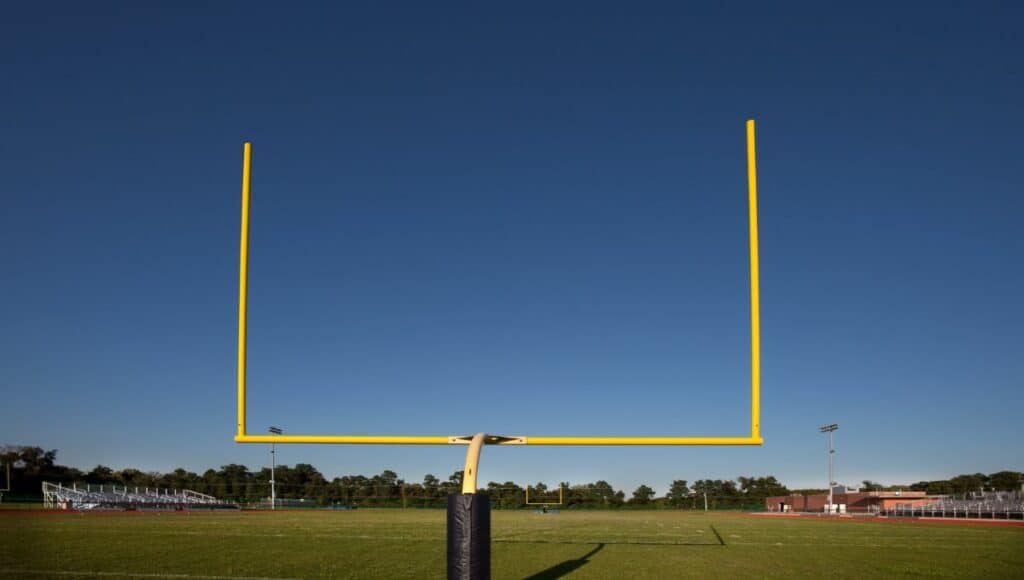High School Field Goal Post Dimensions: Standards and Regulations
In the realm of high school football, the dimensions of the field goal posts play a critical role in the game. These structures are the vertical canvas on which kickers paint their high-flying field goals and extra points. To understand their significance, it’s essential to grasp the standard measurements that govern their size and placement on the field. Adhering to these dimensions ensures fair play across high school games and aligns the sport with recognized regulations.

Field goal posts at the high school level have specific dimensions, which are different from those used in college and professional leagues. The goal posts mark the boundary of the scoring area and act as the focal point for scoring field goals and extra points. Knowledge of the exact height, width, and other regulatory dimensions of the field goal posts is crucial for players, coaches, and officials who participate in high school football games, ensuring that all games are played under uniform guidelines.
Key Takeaways
- Field goal posts’ dimensions are central to the game rules.
- Accurate measurements ensure uniformity across high school games.
- Regular maintenance of goal posts is necessary for safety and regulation compliance.
Overview of High School Football Field Dimensions
When you look at a high school football field, you’ll notice it is marked with a symmetrical layout and precise measurements that are crucial for the flow of the game.
Field Size and Markings
A standard high school football field is 120 yards long, which includes two 10-yard end zones. In width, the field extends 53 1/3 yards. The yard lines run parallel to the end zones at every 5-yard interval and are marked across the field from sideline to sideline.
To assist players and officials in identifying location on the field, hash marks are placed parallel to the yard lines.
In high school football, these marks are 53 feet, 4 inches apart, which is wider than both NCAA and NFL hash marks.

High School vs. NCAA and NFL Differences
When comparing high school to the NCAA and NFL, there are notable differences in dimensions. For instance, while the overall field length including the end zones is the same, the placement of the hash marks differs.
In high school games, they are farther apart, offering a different tactical consideration for teams. The goal posts in high school football are also placed differently.
They are 23 feet, 4 inches wide, which is wider than NCAA posts at 18 feet, 6 inches and even more so compared to the NFL’s 18 feet, 6 inches. These variations can affect kicking and game strategies.
High School Football Goal Post Specifications
High school football games are governed by precise equipment specifications, particularly for field goal posts.
You’ll find that these specifications not only contribute to the uniformity of play across various fields but also ensure the safety of the players during the game.
Goal Post Dimensions
The National Federation of State High School Associations (NFHS) sets forth the official dimensions for high school football goal posts.
Your goal posts should have an inside width of 23 feet, 4 inches, matching college and NFL requirements. The crossbar should sit 10 feet above the playing field, ensuring a clear and measurable target for kickers.
- Overall Height: The posts extending above the crossbar should be at least 20 feet tall.
- Post Diameter: The outside diameter of each post should not exceed 4 inches.
For your note-taking or field setup document:
| Component | Specification |
|---|---|
| Inside Width | 23 feet, 4 inches |
| Crossbar Height | 10 feet |
| Post Diameter | 4 inches maximum |
| Minimum Post Height | 20 feet above crossbar |
Materials and Safety Considerations
When selecting your goal posts, prioritize safety and durability. The materials typically used include aluminum or steel, both offering longevity and stability.
The NFHS recommends padding be used around the goal posts to minimize injury risks during collisions.
- Materials: Opt for treated aluminum or galvanized steel to withstand various weather conditions and frequent use.
- Safety: The goal post base, at ground level, should be padded, and the design should avoid any sharp or rough edges to prevent injuries.
Adhering to the NFHS standards will guarantee your field aligns with high school football regulations and that player safety is upheld during every field goal attempt.
Installation and Maintenance of Field Goal Posts
The installation and maintenance of field goal posts are critical for the safety and functionality of high school football fields. Properly installed and maintained posts ensure a fair and regulated game, whether played on natural grass or artificial turf.
Installation Process
When you are ready to install football goal posts, start by ensuring you have a clear plan. This plan should consider the team area and end line to align correctly with high school football regulations. The goal posts must be anchored securely at the end line of the field.
Installation Steps:
- Positioning: Place the goal posts exactly on the end line, maintaining the correct distance between the two uprights as specified by high school football regulations.
- Excavation: Dig holes for the posts following the manufacturer’s depth and diameter recommendations to provide sufficient stability.
- Setting: Insert the posts into the holes. If you’re installing on natural grass, you may use concrete to secure the posts. For artificial turf, use a base that is compatible with the turf system.
- Alignment: Ensure the posts are vertical with a level before the final setting.
- Securing: Once the posts are aligned, secure them in place. For natural grass, this often means pouring concrete around the base, whereas for artificial turf, anchoring methods will vary.
Regular Maintenance
Maintaining your high school football goal posts is important to ensure they remain safe and functional throughout their use.
Regular maintenance tasks vary based on whether the field has natural grass or artificial turf, but some key points apply to both.
Maintenance Tasks:
- Inspection: Conduct regular inspections to check for rust, wear, or damage, especially after severe weather.
- Cleaning: Keep the posts clean from debris and dirt to prevent corrosion.
- Painting: Apply rust-resistant paint as needed to protect the metal surfaces.
- Tightening: Periodically check that bolts and other fastenings are tight and secure.
By following these specific installation and maintenance guidelines, you will support the integrity and longevity of your high school’s football field setup.
Future Trends in Football Field Design
As American football evolves, so do the facilities and equipment associated with it, including the very dimensions and features of the field you play on.
Expect to see practical enhancements reflecting safety, game pace, and technology integrations aimed directly at goal posts and field safety.
Innovations in Goal Post Technology
In the near future, goal post technology will likely become more sophisticated, incorporating materials and designs that aim to improve visibility and accuracy.
Goal posts might feature advanced composites for enhanced durability and sensors for automatic scoring validation.
Your experience with goal post dimensions might change slightly, adhering to evolving regulations that strive for consistency across high school, college football, and all-pro levels.
Developments in Field Safety
Safety remains paramount; thus, future football fields will be engineered to reduce player injuries. This includes the area surrounding the goal posts and team benches.
The turf around these areas could be embedded with impact-absorbing materials.
Additionally, expect better demarcation of field numbers and boundaries with non-toxic, high-contrast paints that provide clarity for you without compromising your health.
